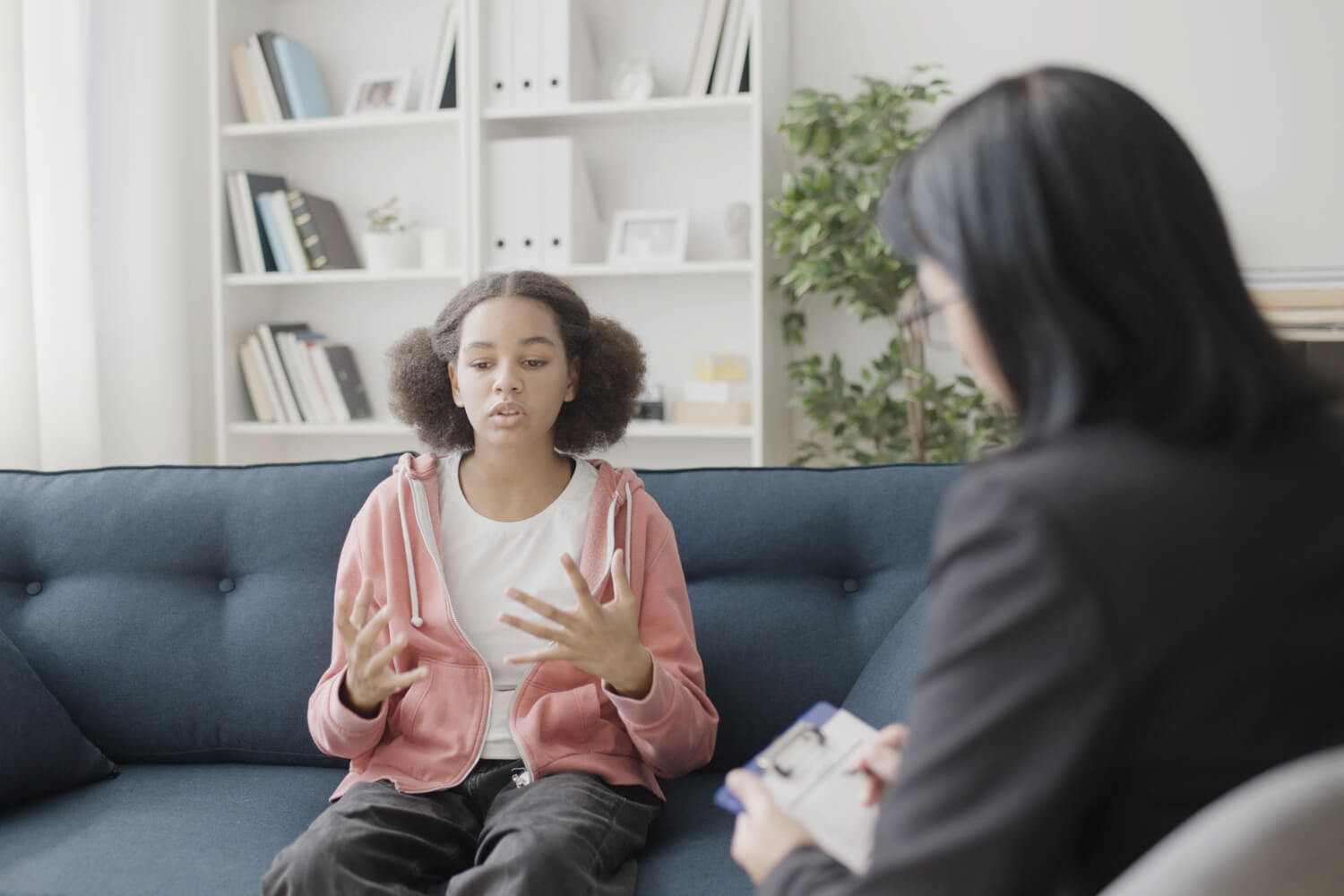The Role of a Therapist for Teenagers: Sorts Of Treatment and Their Influence on Youth Mental Wellness
The function of a therapist for teenagers is vital in attending to the complexities of teenage mental wellness. Different healing strategies, such as Cognitive-Behavioral Therapy and Art Treatment, deal customized assistance to satisfy individual needs. Therapists For Teens. These methods not just help in managing anxiousness and anxiety but also promote psychological expression. Recognizing these therapies and their effects reveals crucial understandings into exactly how young individuals navigate their mental wellness trips, elevating concerns about their performance and availability
Understanding Teen Mental Wellness Challenges
As teenagers browse the intricacies of maturing, they frequently encounter various mental health obstacles that can significantly affect their growth. Typical concerns consist of identification, clinical depression, and stress and anxiety situations, which can emerge as a result of scholastic pressures, social characteristics, and domestic expectations. During this duration of substantial adjustment, teenagers may battle to express their sensations, bring about complication and isolation.
The pressure to comply with peer requirements can aggravate sensations of inadequacy, while social media might magnify comparisons and insecurity. In addition, hormone changes add to psychological volatility, complicating their capacity to cope with stress and anxiety.
Understanding these obstacles is necessary for parents, educators, and psychological health specialists. Youth Counselling Near Me. Recognition fosters an atmosphere where teens feel verified and sustained, enabling them to seek aid when needed. By identifying and attending to these psychological health concerns early, intervention methods can be implemented to advertise resilience and general well-being throughout this important developing phase

Exploring Various Kinds Of Treatment for Teens
While teenagers deal with a myriad of mental health difficulties, different healing methods can properly address their unique requirements. One extensively utilized method is Person-Centered Treatment, which emphasizes compassion and genuine favorable regard, permitting teens to explore their sensations in a safe atmosphere. Dialectical Habits Treatment (DBT) concentrates on training emotional law and interpersonal skills, making it especially valuable for those with intense emotions.
One more efficient approach is Art Therapy, which utilizes innovative expression to assist teenagers communicate feelings that may be difficult to express verbally. Group Therapy likewise provides an encouraging setting where adolescents can share experiences, fostering a feeling of belonging and minimizing seclusion. Lastly, Household Treatment engages relative in the healing procedure, dealing with relational dynamics that might contribute to a teenager's mental wellness problems. These varied therapeutic modalities offer important support and can lead to substantial improvements in teen mental health.
The Benefits of Cognitive-Behavioral Treatment
Cognitive-Behavioral Treatment (CBT) stands out amongst the different therapeutic methods offered for teenagers, offering a structured framework for addressing mental health and wellness obstacles. Youth Counselling. This evidence-based therapy concentrates on determining and changing adverse idea patterns and actions, advertising much healthier coping strategies. One considerable benefit of CBT is its ability to empower teenagers by furnishing them with sensible devices to handle stress and anxiety, depression, and various other emotional problems
CBT is usually goal-oriented and time-limited, which can be especially appealing to teens and their families seeking concrete results. By promoting self-awareness, teens learn to acknowledge triggers and create problem-solving abilities. Additionally, CBT encourages open communication between the therapist and the teenage, helping with an encouraging atmosphere for reviewing individual concerns. The abilities obtained throughout CBT sessions can result in long-term improvements, assisting teens navigate life's challenges much more effectively, ultimately enhancing their total psychological health.
The Creative Expression of Art Therapy
Art therapy offers an unique outlet for teenagers to explore and express their feelings artistically, allowing them to connect feelings that may be challenging to articulate vocally. This therapeutic approach motivates self-discovery and individual reflection with numerous artistic tools, such as paint, attracting, or sculpting. By taking part in creative tasks, adolescents can confront and process their emotions in a safe atmosphere, allowing them to obtain insight into their inner experiences.
The non-verbal nature of art therapy can be specifically advantageous for those that fight with conventional talk therapies. As teenagers create art, they might uncover underlying problems and establish dealing strategies to manage their obstacles. Additionally, art treatment fosters a sense of accomplishment and improves self-confidence, as people can reveal themselves in an unique method. Ultimately, this kind of therapy not only boosts psychological expression yet also advertises mental health and well-being amongst adolescents.
Structure Strength Through Supportive Restorative Relationships

Via constant engagement, specialists can help teens recognize their toughness and weaknesses, advertising self-awareness and personal growth. This encouraging dynamic not only improves psychological wellness however likewise imparts a sense of belonging, which is essential during the troubled adolescent Youth Counsellor years.

The therapeutic partnership offers as a design for healthy and balanced interpersonal links, showing teenagers just how to connect successfully and establish borders. Ultimately, a strong therapeutic partnership lays the structure for strength, making it possible for teens to navigate life's adversities with higher confidence and versatility.
Often Asked Concerns
Just How Can Moms And Dads Support Their Teens During Therapy Sessions?
Parents can support their teens throughout treatment by actively paying attention, urging open communication, valuing confidentiality, and showing compassion. They must likewise educate themselves about the restorative process and be patient with their teenager's psychological trip.

What Signs Suggest a Teen May Demand Treatment?
Indicators showing a teen may need treatment include consistent despair, withdrawal from tasks and buddies, drastic modifications in behavior, scholastic decrease, enhanced impatience, compound usage, difficulty focusing, and revealing feelings of hopelessness or unimportance.
How Much Time Does Therapy Usually Last for Teenagers?
Treatment for teens generally lasts from a few weeks to a number of months, depending on the person's goals and demands. Sessions generally happen weekly, with progression reviewed consistently to establish the ideal period and frequency.
Are Online Therapy Sessions Effective for Teens?
Study suggests that online therapy sessions can be reliable for teenagers, providing availability and benefit. However, end results depend upon individual choices, the quality of the therapeutic connection, and the certain systems made use of for sessions.
Just How Can Teens Choose the Right Therapist on their own?
Teenagers can choose the right specialist by considering compatibility, competence in adolescent problems, and therapeutic method. They ought to feel comfy discussing worries, and it's advantageous to seek recommendations from trusted adults or peers.
Different restorative techniques, such as Cognitive-Behavioral Treatment and Art Therapy, deal tailored support to satisfy specific requirements. One more efficient technique is Art Treatment, which makes use of creative expression to assist teens interact feelings that may be difficult to articulate verbally. Cognitive-Behavioral Treatment (CBT) stands out amongst the different healing approaches available for teenagers, supplying an organized framework for addressing psychological wellness obstacles. Art therapy offers a distinct outlet for teenagers to discover and express their emotions artistically, allowing them to interact feelings that may be difficult to articulate vocally. The non-verbal nature of art treatment can be particularly beneficial for those who have a hard time with typical talk therapies.